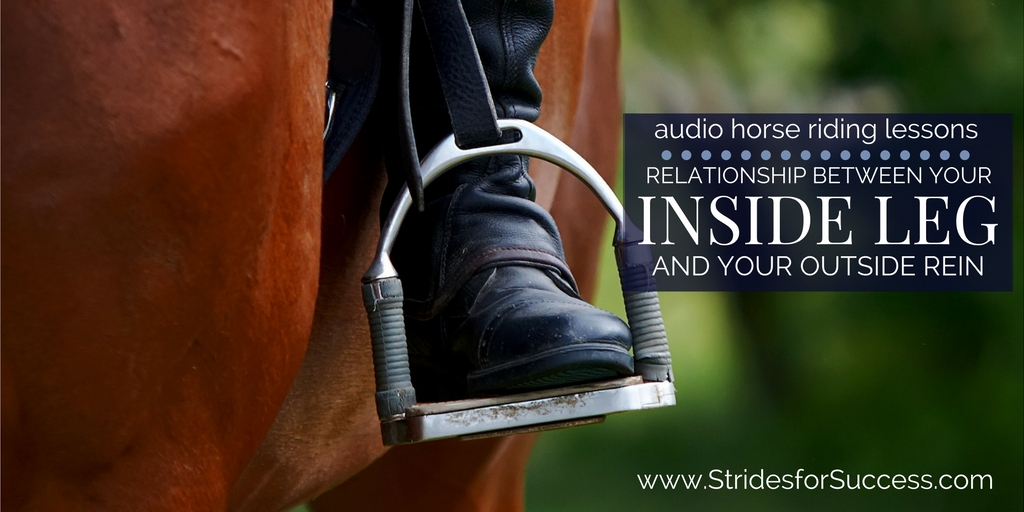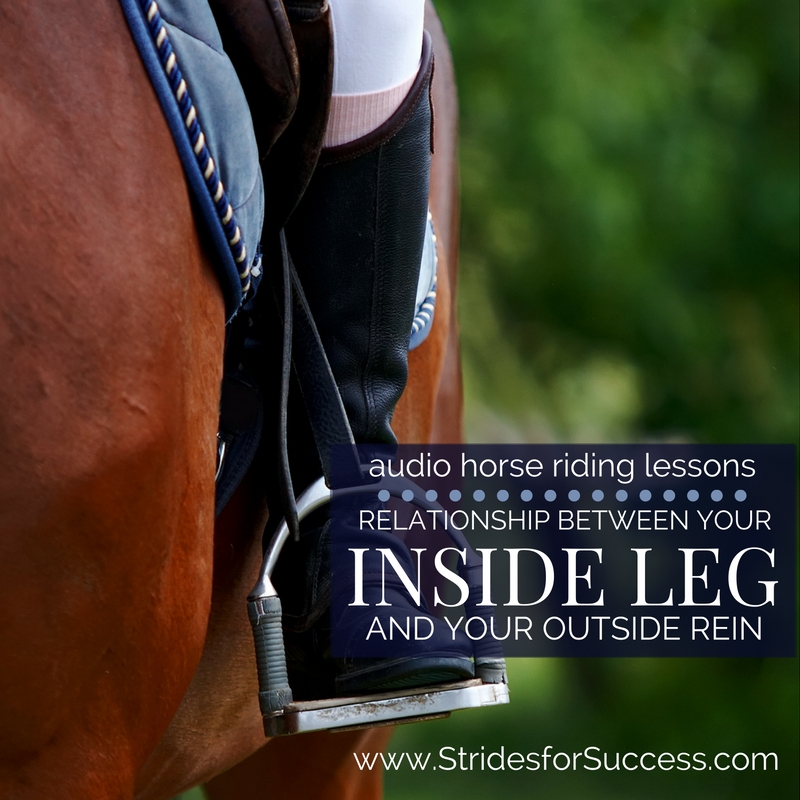Most riders have heard about how they should ‘ride from the inside leg to the outside rein’; but really – what does that mean?! How exactly do you ride from what seems like a bit of a diagonal and what about all the other aids? Should we forget about them?
The term ‘riding from the inside leg to the outside rein’ is one that is used a lot when it comes to riding. The confusing part of it however, is that this concept is so much more than just those two aids. In fact if it is done correctly, it is a finely balanced combination of all your aids – that is continuously requiring adjustment and ‘recalibration’ with every passing stride.
A channel for your horses energy
What is important to remember is that your aids are like a channel for your horses energy. Think about the banks of a river; they keep the water in, and therefore, flowing where they want it to go. Your aids work in the same way for the energy your horse creates.
When you ride, you ask your horse to create energy with his hind quarters. This energy must then be directed where you want it to go. If you allow it to just ‘run out the front’, your horse will most probably become quite long and stringy. He will also become heavy on his forehand. If you hold too much energy in and don’t allow it to flow, you run the risk of encountering an explosion of sorts!
Understanding that your job is to ask for the creation of energy and then regulate the flow is, in my opinion, the first step to grasping the concept of the ‘inside leg to outside rein’.

How responsive is your horse to your aids?
From here, you need to asses how responsive your horse is to your aids, particularly your inside leg. Is he quick to respond to questions you ask with it, and does he clearly understand what is expected of him when you ask those questions?
Your inside leg asks for the energy to be created. This energy is created in the hind quarters and then flows though the horses back to connect with the front end. As we have already mentioned your aids then channel the flow of this energy. However this cannot happen if your horse ignores or is unresponsive to your questions to begin with.
You cannot channel and regulate what is not there!
The Role of Your Outside Rein
So once this energy is flowing, your inside leg is then used to ‘contain’ it and keep it in the imaginary river that we spoke about earlier. However, all rivers need two banks. This is where your outside rein comes into play. it is the opposing channel or bank for the inside leg.
Now, obviously, this is a very simplified version of what is going on, however in order to fully understand how they work together, I find it is one of the easiest ways to explain the concept.
What is important to realise is that it is this relationship, between inside leg and outside rein, that then dictates how that energy flows through the horse. If it is allowed to run freely out the front, or if it will be regulated.
If you are regulating that flow of energy, you then need to begin working on how you are balancing that flow.
Balancing Your Inside Leg to Your Outside Rein
Again, think of the energy as being water in a river. If it is allowed to run freely out, it will be fast and lack direction. If it is dammed up, their is much more potential there to work with. If it is blocked, well, it may just explode (think bucking and general high jinx)!
You need to work on balancing the energy being created, keeping the energy flowing in the ‘river’ and deciding how much you are going to allow it to flow out. Once you understand this, it is now time to incorporate your other aids into your communication.
Your Other ‘Supporting’ Aids
In order for the relationship between the inside leg and outside rein to truly work; your outside leg, inside rein and seat must also be involved. Their role is more of a supporting one – they are not the lead characters in the relationship!
The additional involvement of your inside rein and outside legs will constantly change, depending on the questions you are asking your horse and his response. If you fail to incorporate them into your riding, the basic principle of your inside leg to outside rein cannot work effectively.
However, if you overuse the supporting aids, well it’s a little like “too many cooks spoiling the broth”. It becomes overwhelming, each aid fighting for your horses attention and consideration. This is where you see the horse either shutting down completely and ignoring the rider, or becoming agitated, frustrated and displaying far too much excess tension throughout their body.

Fine Tuning this Relationship
Initially you may have to use more pressure or apply your aids more frequently until your horse begins to understand what you are asking. How long it takes until you can begin to become more subtle with your aids will depend on your riding skills – and how quiet you are when riding – and also your horses training.
Refining the relationship between your inside leg and outside rein means having your seat and body play a larger part in your communication with your horse.
Begin by Focusing on the Where & How
I suggest you begin by focusing on your position in the saddle. If you are in the correct position, your body is in the best place to apply the aids clearly and correctly. This is true for your leg and your rein.
Pay attention to your ‘lines’; head, shoulder, hip, heel and then ‘elbow, wrist, thumb, rein, bit’. When those correct lines are in place will have a dramatic influence on the effectiveness of your aids.
From here, work on your horses responsiveness to your aids and how much pressure and how often you are applying those aids. This is always changing, from stride to stride, so it is up to you to begin developing your feel in order to consistently adapt your aids to the situation.
Happy Riding
Lorna
There are four more audio programs on this topic available for you to download and listen to while riding inside of Daily Strides Premium. The additional programs will take you step by step through the process of applying these aids when riding, helping you to better understand and apply this concept in the saddle.
They are part of the ‘Rider Aids Collection’, a series of audio programs all about the different aids we use when riding and how you can best apply yours. This collection is divided into Seat Aids, Leg Aids and Rein Aids; allowing you to find the group of lessons that best suit your particular needs – regardless of where you are in your riding.
You can find out more by visiting HERE >>
[wp-tiles post_type=”post” orderby=”date” order=”DESC” grids=”News”]
